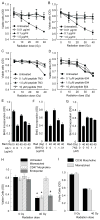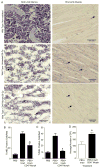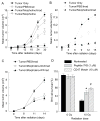Radioprotection in normal tissue and delayed tumor growth by blockade of CD47 signaling
- PMID: 20161613
- PMCID: PMC2811586
- DOI: 10.1126/scitranslmed.3000139
Radioprotection in normal tissue and delayed tumor growth by blockade of CD47 signaling
Abstract
Radiation-induced damage of normal tissues restricts the therapeutic doses of ionizing radiation that can be delivered to tumors and thereby limits the effectiveness of radiotherapy. Thrombospondin-1 signaling through its cell surface receptor CD47 limits recovery from several types of stress, and mice lacking either gene are profoundly resistant to radiation injury. We describe strategies to protect normal tissues from radiation damage using CD47 or thrombospondin-1 antibodies, a CD47-binding peptide, or antisense suppression of CD47. A morpholino oligonucleotide targeting CD47 confers radioresistance to human endothelial cells in vitro and protects soft tissue, bone marrow, and tumor-associated leukocytes in irradiated mice. In contrast, CD47 suppression in mice bearing melanoma or squamous lung tumors prior to irradiation result in 89% and 71% smaller tumors, respectively. Thus, inhibiting CD47 signaling maintains the viability of normal tissues following irradiation while increasing the radiosensitivity of tumors.
Figures







Similar articles
-
Blockade of CD47 increases survival of mice exposed to lethal total body irradiation.Sci Rep. 2013;3:1038. doi: 10.1038/srep01038. Epub 2013 Jan 8. Sci Rep. 2013. PMID: 23301159 Free PMC article.
-
Thrombospondin-1 and CD47 limit cell and tissue survival of radiation injury.Am J Pathol. 2008 Oct;173(4):1100-12. doi: 10.2353/ajpath.2008.080237. Epub 2008 Sep 11. Am J Pathol. 2008. PMID: 18787106 Free PMC article.
-
CD47 is necessary for inhibition of nitric oxide-stimulated vascular cell responses by thrombospondin-1.J Biol Chem. 2006 Sep 8;281(36):26069-80. doi: 10.1074/jbc.M605040200. Epub 2006 Jul 11. J Biol Chem. 2006. PMID: 16835222
-
Enhancing cardiovascular dynamics by inhibition of thrombospondin-1/CD47 signaling.Curr Drug Targets. 2008 Oct;9(10):833-41. doi: 10.2174/138945008785909338. Curr Drug Targets. 2008. PMID: 18855617 Free PMC article. Review.
-
Divergent modulation of normal and neoplastic stem cells by thrombospondin-1 and CD47 signaling.Int J Biochem Cell Biol. 2016 Dec;81(Pt A):184-194. doi: 10.1016/j.biocel.2016.05.005. Epub 2016 May 6. Int J Biochem Cell Biol. 2016. PMID: 27163531 Free PMC article. Review.
Cited by
-
Blockade of CD47 increases survival of mice exposed to lethal total body irradiation.Sci Rep. 2013;3:1038. doi: 10.1038/srep01038. Epub 2013 Jan 8. Sci Rep. 2013. PMID: 23301159 Free PMC article.
-
Thrombospondins and remodeling of the tumor microenvironment.Vessel Plus. 2018;2:30. doi: 10.20517/2574-1209.2018.40. Epub 2018 Oct 10. Vessel Plus. 2018. PMID: 32984773 Free PMC article.
-
Thrombospondin-1 in urological cancer: pathological role, clinical significance, and therapeutic prospects.Int J Mol Sci. 2013 Jun 7;14(6):12249-72. doi: 10.3390/ijms140612249. Int J Mol Sci. 2013. PMID: 23749112 Free PMC article. Review.
-
Combination of anthracyclines and anti-CD47 therapy inhibit invasive breast cancer growth while preventing cardiac toxicity by regulation of autophagy.Breast Cancer Res Treat. 2018 Nov;172(1):69-82. doi: 10.1007/s10549-018-4884-x. Epub 2018 Jul 28. Breast Cancer Res Treat. 2018. PMID: 30056566 Free PMC article.
-
miR-222 enhances radiosensitivity of cancer cells by inhibiting the expression of CD47.Int J Clin Exp Pathol. 2019 Nov 1;12(11):4204-4213. eCollection 2019. Int J Clin Exp Pathol. 2019. PMID: 31933820 Free PMC article.
References
-
- Nair CK, Parida DK, Nomura T. Radioprotectors in radiotherapy. J Radiat Res (Tokyo) 2001;42:21–37. - PubMed
-
- Emami B, et al. Tolerance of normal tissue to therapeutic irradiation. Int J Radiat Oncol Biol Phys. 1991;21:109–122. - PubMed
-
- Stone HB, Coleman CN, Anscher MS, McBride WH. Effects of radiation on normal tissue: consequences and mechanisms. Lancet Oncol. 2003;4:529–536. - PubMed
-
- Duchstein S, Gademann G, Peters B. Early and late effects of local high dose radiotherapy of the brain on memory and attention. Strahlenther Onkol. 2003;179:441–451. - PubMed
-
- Coleman CN. Radiation oncology--linking technology and biology in the treatment of cancer. Acta Oncol. 2002;41:6–13. - PubMed
MeSH terms
Substances
Grants and funding
LinkOut - more resources
Full Text Sources
Other Literature Sources
Research Materials

